Just so you know, as an Amazon Associate we earn from qualifying purchases made via bold red links, buttons or images.
Last Updated on December 3, 2023
So you’ve decided to buy a Moccamaster.
Congratulations. That was the easy part of the decision. The Dutch coffee machine by Technivorm is known worldwide as the best drip coffee maker money can buy. But now that you’ve decided to commit some extra money to get the Moccamaster’s quality and durability, you’re probably left looking at all those models and wondering, “Which Moccamaster should I buy?”
Deciding which Technivorm Moccamaster to buy can be overwhelming. Moccamaster USA markets 10 different models, each with a different combination of letters at the end of their name. In Europe, Technivorm markets even more models. And when you first glance at them, they don’t look all that different from each other:
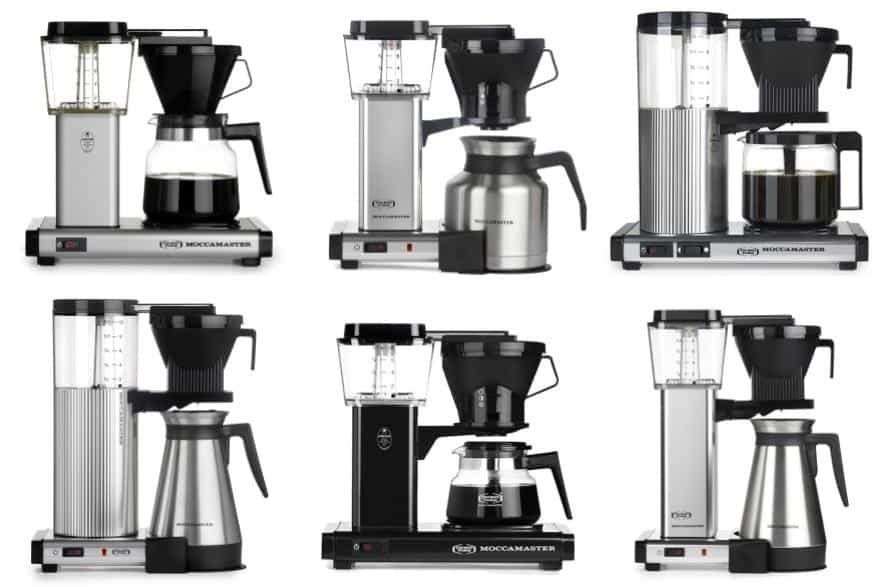
We’re here to help. There is a method to the alphabetic madness Technivorm uses in naming its models. We’ll do our best to explain it here. You should come away with a good idea about which Moccamaster to get.
We’re going to assume that you are looking at Moccamasters that brew 5-10 cups of coffee at a time, for home use. The company also makes Grand models for offices and cafés. We’re assuming that’s not for you. And if you’re looking for a single-cup maker, Technivorm makes one of those called the Cup One. But this post is concerned primarily with the typical family-size coffee maker for the home.
How Technivorm Moccamaster models get their names
Technivorm Moccamaster model names are usually differentiated by a series of letters at the end. For example, their most popular machine is the KBGV:
- Perfect Coffee Every Time: This pump-free coffee maker heats water to the correct temperature for coffee extraction
- Brew-Volume Selector switch for brewing half or full carafes Easy to Use: The Moccamaster brews a full 40 oz pot of coffee in 4-6 minutes using one switch
- Easy to Use: The Moccamaster brews a full 40 oz pot of coffee in 4-6 minutes using one switch
- Quiet and Safe: The Moccamaster Select quietly brews your coffee and automatically turns off after 100 minutes
- Delicious Coffee and Peace of Mind: Moccamaster coffee brewers have a 5-year warranty
Here’s what the letters mean, and we’ll explain the differences in more detail below:
| KB | Rectangular body column |
| G | Automatic drip stop |
| V | Volume control |
| T | Thermal steel carafe |
| CD | Cylindrical body column (Europe only) |
| H | Single-setting hotplate (Europe only) |
So the KBGV model described above has a rectangular body column (KB), automatic drip stop (G) and volume control (V). The absence of a T means it has a glass carafe rather than thermal steel, and the absence of an H means it has two hotplate temperature settings (H models are only found in Europe anyway).
Now that you have an idea which features are represented by which letters, let’s talk about what those features actually mean for you and your coffee machine.
Glass vs. thermal carafe
The first and most important decision you must make when deciding on a Moccamaster is whether you want a glass or thermal steel carafe.
KB: Glass carafe
KBT: Thermal carafe
If you choose glass, your machine comes with a hotplate and your carafe must be on it for the coffee to stay warm. The hotplate and boiler are powered by separate elements, so the hotplate can keep the coffee at the ideal serving temperature of 176-185 F rather than the 196-205 F required for brewing.
Models with the thermal carafe have no hotplate. That means you can take the carafe into a separate room and set it down. The doubled-walled stainless steel container will keep the coffee at serving temperature. You get mobility with the thermal carafe.
The combination of glass and hotplate generally keeps coffee hotter, for longer. A thermal carafe can do the job for a few hours, but no more. One trick that helps is to heat up the stainless steel carafe using hot tap water before you brew the coffee. You don’t have to do this, but it will prolong the heat.
Of course, the glass carafe is more breakable than steel. Technivorm’s glass is known to be particularly strong, but it can’t match the durability of steel.
The glass carafe, with its wider opening, is a little easier to clean. Not only is it easier to get your hand in, but the glass also doesn’t seem to require quite as much aggressive scrubbing as the steel.
One last consideration is the taste imparted by the materials. Some people find that stainless steel lends a taste to coffee, particularly if it comes into contact with the coffee for a long time. You rarely hear the same about glass. This is probably not even worth thinking about if you drink your coffee soon after brewing rather than leaving it around. But if your coffee is likely to sit for a while, it’s something to consider.
Here the folks at Seattle Coffee Gear try a taste test using a glass-carafe Moccamaster and a steel-carafe model, drinking the coffee one hour after brewing to see if they can taste a difference. They come to the same conclusion:
So now that you have some information about the glass carafe vs. thermal steel, what’s it going to be? Once you’ve decided, these are the models you now have available to you:
| Glass | Thermal steel | |
|---|---|---|
| 10-cup | • KBG • KB • KBGV (or “KBGV Select”) • HB (Europe) • HBG (Europe) | • KBGT • KBT • CD AO (Europe) |
| 8-cup | • KBS (Europe) | • KBTS |
Volume control
So let’s talk about that ‘V’ in the KBGV.
Moccamaster introduced the KBGV, also known as the KBGV Select, in 2021. Its main feature is a unique switch where you would normally find the hotplate temperature switch on other Moccamaster models. You can see it on the base of this unit below, right next to the power switch.
On the KBGV, this switch automatically adjusts the brewing parameters based on whether you’re brewing a half carafe or a full carafe of coffee. (The ‘V’ stands for volume.)
In particular, it adjusts the temperature of the hotplate and the speed at which the water flows during brewing.
The hotplate temperature is important, because a smaller volume of coffee heats more quickly, and you don’t want your coffee to taste burnt. The KBGV will automatically lower this temperature a bit if you’re only brewing a half carafe.
The water flow is even more important, because one of the biggest factors determining your coffee’s flavor is the length of time the ground beans spend in contact with hot water. This is when the flavor gets extracted. Think about it: If you’re brewing half a carafe and using half as much water, but the water flows at the same speed it always does, then it will pass through the coffee grounds much more quickly than it does when you brew a full carafe. The beans will spend less time in contact with water and be under-extracted.
The KBGV addresses this by automatically slowing the water flow when you brew half a carafe. This keeps the water in contact with the beans long enough to extract maximum flavor, according to standards established by the European Coffee Brewing Centre.
So if you can see yourself bouncing back and forth between a full carafe and a half carafe quite frequently, the KBGV would be a great choice:
Capacity: 10-cup or 8-cup
Your next consideration should probably be capacity. Since we’re assuming here that you’re buying a regular household coffee maker and not a machine for your café, that means 10 cups or 8 cups.
Keep in mind that Technivorm is a European company, and coffee cups are smaller in Europe. Technivorm considers a cup to be 4 ounces. That’s half of a standard measuring cup. In the U.S., coffees typically start at 12 ounces (a normal coffee mug or a “tall” drink at Starbucks). So if you buy what Technivorm calls a “10-cup” machine, it will brew 40 ounces, which is the equivalent of about 3.5 mugs. If you buy an “8-cup” machine, you get less than three mugs.
As you can see in the chart above, the selection is much broader at the 10-cup size. You cannot find an KBGV in the 8-cup size.
If you know you want an 8-cup machine with a thermal steel carafe, congratulations! You’re done. Go get yourself a Technivorm Moccamaster KBTS:
If you really want an 8-cup machine with glass, you may have to look to Europe for a KBS, because they are seldom available in the U.S.
Things get a little more complicated for those who want a 10-cup machine. Let’s break it down further by looking at what’s left in the glass and steel categories.
10-cup machine, glass carafe
Your options here are the KBGV, KB (read our review), HBG and HB (Europe only). Let’s start by differentiating the ‘K’ models from the ‘H’ models.
The ‘K’ indicates that the machine has a hotplate with two settings. The lower setting will keep your coffee at 175 F, while the hotter setting will crank it up to 185 F. Both are perfectly acceptable serving temperatures and neither will burn your coffee if you keep the carafe on there for a while.
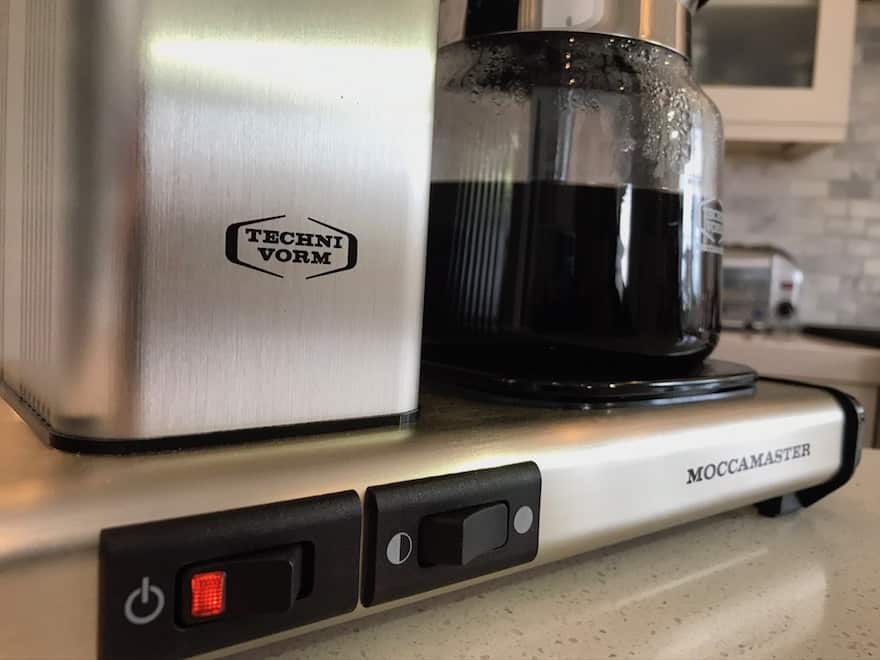
The ‘H’ models have only the lower hotplate setting, so about 180 F is the only option. Otherwise, these machines match their ‘K’ counterparts.
Once you’ve chosen between an ‘H’ model and a ‘K’ model, the only remaining difference is the ‘G’. One will have it, one won’t. The ‘G’ is all about the drip stop, and the drip stop will be either automatic or manual. We explain farther down this page.
10-cup machine, thermal steel carafe
Your options here are the KBGT and KBT. (In Europe, the CD AO is also an option but that machine and its unique cylindrical main column has largely disappeared from North America.)
KBGT: Rectangular column
In North America, your choice is between the KBGT and the KBT, so let’s get to the bottom of that ‘G’! One has it, one doesn’t. This is all about the drip stop.
What is a drip stop?
Moccamasters come with either an automatic drip stop (indicated by a ‘G’) or a manual drip stop (no ‘G’). The drip stop is a mechanism that controls the flow of coffee out of the brew basket and into the carafe. It’s essentially a valve at the bottom of the basket that can be open or closed, or in the case of the manual drip stop, half-open.
Moccamaster manual vs. auto drip stop
Which drip stop you choose should depend on how much control you want over the brewing process. The automatic drip stop doesn’t do much except block the flow of coffee when you remove the carafe from under the basket. So if you’re halfway through a brew and can’t wait to pour yourself a cup, you can remove the carafe and the machine will stop flowing until it is replaced. You won’t get a mess. Otherwise, automatic drip stop is for the set-it-and-forget-it crowd.
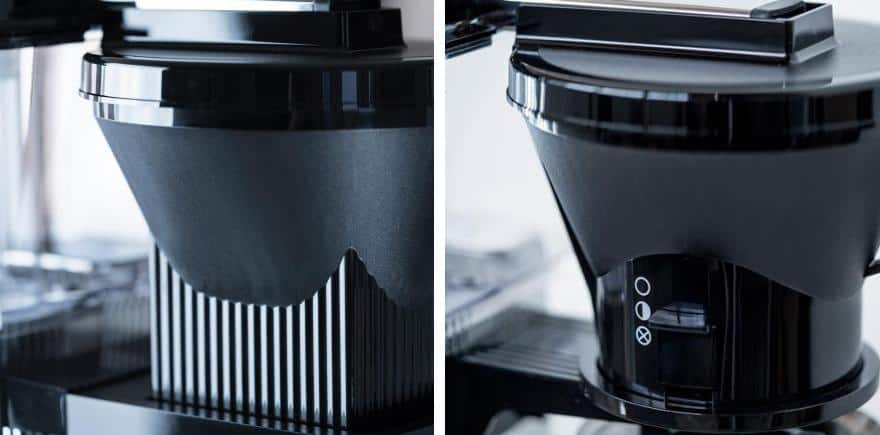
A manual Moccamaster drip stop allows you to halt or slow the flow at any point in the brewing process, so you have a lot more control. This allows for more advanced brewing. It’s great for coffee aficionados who like to experiment. For example, you can let in a little bit of water to “bloom” the coffee grounds for 30 seconds, and then resume the flow. Or if you want to make a really small batch of coffee, say 1-3 cups, you can slow the flow by leaving the drip stop half open, or even close it and hold water in the brew basket for a couple of minutes before letting it out. The ideal saturation time for coffee is 4-6 minutes, so either of these measures will ensure the water doesn’t pass through the grounds too quickly and leave your coffee under-extracted.
In short, the automatic drip stop is less complicated but less flexible. The manual drip stop demands a little more of you, but can reward you with great-tasting coffee at any volume.
Comparing Moccamaster models
We’ve covered all the differences and what they mean, so by now you should have enough information to decide which Moccamaster is best for you. Leaving the Europe-only models out of it, here are the options:
| Model (click for price) | Carafe | Capacity | Hotplate | Housing | Drip stop |
|---|---|---|---|---|---|
| KB | glass | 10 cups | 2 settings | rectangular | manual |
| KBGV | glass | 10 cups | 2 settings, paired with flow control | rectangular | automatic |
| KBGT | steel | 10 cups | none | rectangular | auto |
| KBT | steel | 10 cups | none | rectangular | manual |
| KBTS | steel | 8 cups | none | rectangular | manual |
How to use a Moccamaster
Just because the Moccamaster has sophisticated engineering doesn’t mean it’s hard to use. The process is just the same as with most drip coffee makers.
The manual drip stop adds a small layer of complexity to those models that have it, but not much.
Always start with the power off.
Fill the reservoir with cold water. It has markings that indicate the number of cups.
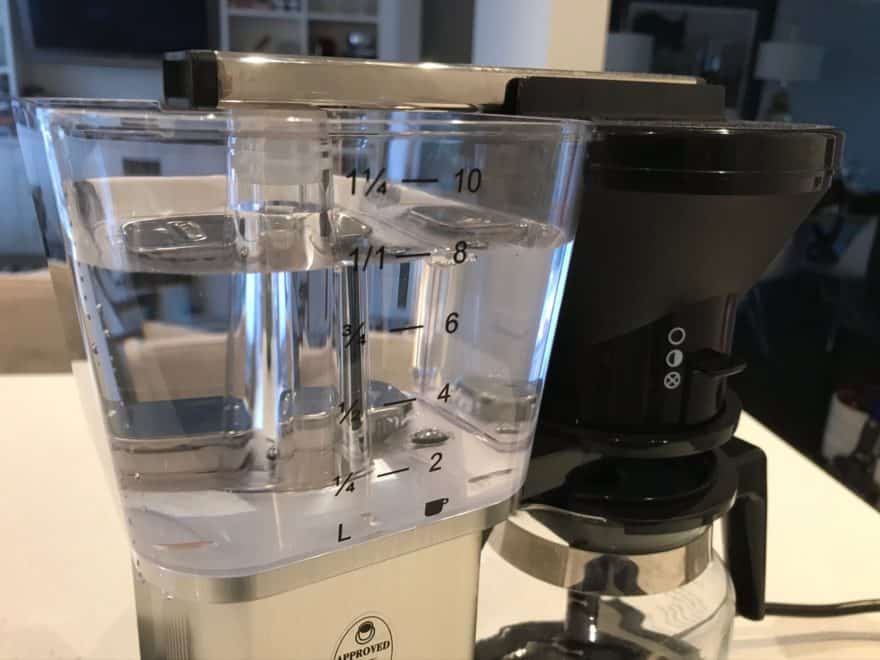
Place a No. 4 paper filter, or a reusable filter, into the brew basket.
Now it’s time to add the coffee.
How to grind coffee for Moccamaster
You want a medium-fine grind for your Moccamaster coffee. If you’ve ever ground for classic pour-over coffee or a Chemex, you want to go a little finer than that. Experiment slightly during your first few brews and you’ll soon get it right.
How much coffee do you put in a Moccamaster?
The ideal Moccamaster coffee scoop ratio is six scoops per litre of water. The machine comes with a scoop that carries about 10 grams (2 tablespoons), so you’ll want six of those (60 grams) for every litre of water. Seven scoops if you’re brewing the full 10 cups.
Now, make sure the drip stop is open. If you have a manual drip stop and it’s in the closed position, the brew basket will flood if the water in your reservoir exceeds its capacity.
Manual drip stops have three positions: open, half-open and closed. The half-open setting is for small batches, to prevent the water from flowing through too quickly and shortening the extraction time.
Now you’re all set. Turn on the power. If you have a hotplate model with two settings, choose your setting—usually the hotter one, unless you’re brewing a really small batch and don’t need it to keep warm for long.
When the coffee stops dripping, your brew is done. Dispose of your coffee grounds and enjoy your coffee while you read our brief history of the Moccamaster.
The story of Technivorm Moccamaster
A Dutch engineer and industrial designer by the name of Gerard-Clement Smit founded Technivorm in the Netherlands in 1964. He had mostly been designing ladders and such, but he came across a coffee maker he thought he could improve upon, and in 1968 created the first Moccamaster.
“A Moccamaster should be the last brewer you’ll ever buy,” Smit once said. The company of about 200 employees has been guided by those words ever since.
A number of qualities set the Moccamaster apart, but from a pure coffee standpoint, what Smit really nailed was the time and temperature of the brew. Brew time for Moccamasters ranges from 4-8 minutes, and the temperature always lands in that scientifically proven sweet spot for coffee, between 196 and 205 F.
The Moccamaster was plastic back in the day, but Technivorm is one of those rare companies that actually decided to improve the quality of their products and materials as they grew, instead of going in the other direction. Today, every Moccamaster is still handmade in the Netherlands. The housing columns are now made of sturdy aluminum rather than the original plastic. Any plastic components they do have are BPA-free. And one of the machine’s most important features is its heating element which is made of copper rather than aluminum. This allows for very quick heating to those perfect, precise temperatures. Technivorm Moccamaster parts are designed to be easily replaced should the need arise.
“A Moccamaster should be the last brewer you’ll ever buy.”
Technivorm’s commitment to quality has helped them sell more than 10 million Moccamaster units since 1968. They are all over Norway and the Nordic countries, as well as many other parts of northern Europe. More recently they have begun to conquer America. (The elegant mid-century modern design doesn’t hurt—the Museum of Modern Art in New York City even sells Moccamasters in its shop.) If you browse the list of certified Specialty Coffee Association of America coffee makers, you’ll find no less than 12 Moccamaster models. As drip coffee makers go, Moccamaster is indeed the gold standard.
Is Moccamaster worth the money?
Moccamaster is worth the money, in the sense that it does indeed deserve to be the highest-priced drip coffee maker on the market. It makes the best coffee. It lasts the longest. Very few people who have owned one would dispute this.
However, this is a subjective question. Not everyone can afford to drop more than $300 on a coffee maker. There are plenty of coffee makers out there at one-third of the price that will suit most people’s needs just fine.
If you want the best and you don’t mind paying for it, rest assured that a Moccamaster won’t let you down.
And by now, hopefully, you know which Moccamaster you should buy.

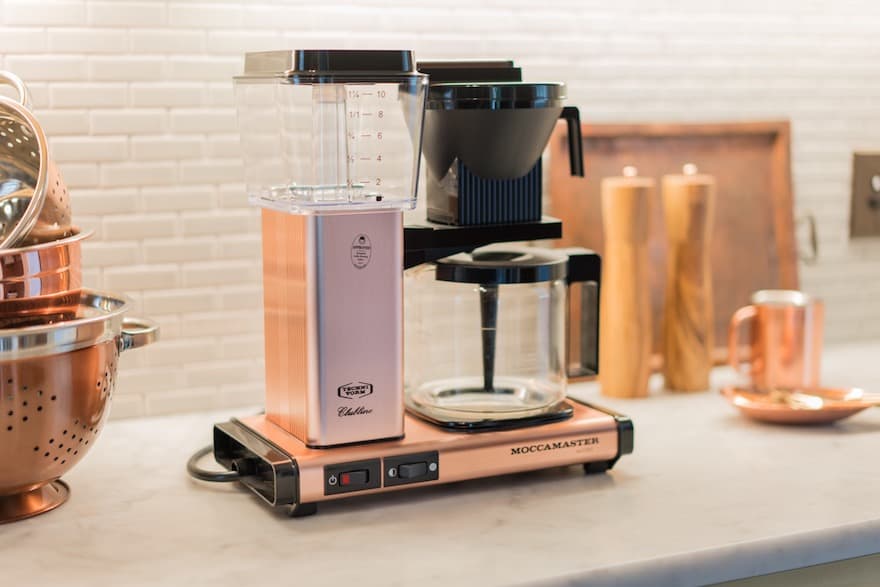








This is, by far, the most informative article I’ve read about these coffee makers. I’m definitely ready to make my decision on which one to purchase. Thank you
Thanks for your guide to the Moccamaster choices. I’m replacing an old KBT and, thanks to you, decided to add the G auto drip stop because the manual stop got inadvertently closed now and then and made a mess of hot, wet coffee grounds on the counter. After that, I taped the valve open. Sorry to say the reason for replacement is that my unit sprung a leak somewhere in the column after about ten years or so of use. I was tempted to take it apart and try to fix it, but I didn’t have the right tools.
I hear you about the manual drip stop! I like it a lot, and I use it to steep the grounds, but I literally will not allow myself to leave the Moccamaster’s side while I’m doing it, because it’s so easy to forget.
Thank you. I just ordered my KBG. I was so confused before seeing this. You guys made it very clear.
So glad to hear it helped. You’ll enjoy that machine!
What does AO reference? Sometimes you see that in the model names. As in Technivorm Moccamaster KBG 741 AO
That stands for “auto off” which means the machine will automatically turn the hotplate off after a certain amount of time. I think it’s around 100 minutes.